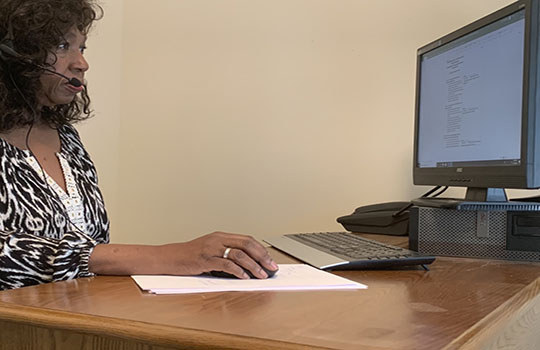A Collaborative Pilot Program with Global Health Access (GHA) Institute, Howard University, Howard Hospital, and American Health Care Professionals Provides COVID-19 Screening, Clinical Care for Vulnerable Populations, and Practicum Experience for Students Across Disciplines
COVID-19 has had a devastating impact on millions of lives and has disproportionately affected those in vulnerable populations. According to reports from the Center for Disease Control, United Nations, World Health Organization, and other governmental entities, those who are impoverished or have pre-existing health conditions, women, children, the sick, people with disabilities, and older adults face heightened risks of infection and serious health consequences from virus.
Despite the increased risks for vulnerable populations, many students were denied the opportunity to work directly with vulnerable populations as higher education institutions around the country were forced to end community-based clinical and practicum training opportunities requiring onsite presence. Mounting needs for care during the pandemic were coupled with significantly reduced numbers of students to offer that care, in order to manage risks to students.

Dr. Molly Davis predicted an urgent shortage of remote-learning opportunities for students to reach vulnerable populations and launched a collaborative telehealth pilot program.
In January, while the nation was just starting to see its first COVID-19 cases, Dr. Molly Davis, professor of Social Work at the George Mason University College of Health and Human Services identified a problem with the loss of clinical hours due to the pandemic. As an advanced telehealth/telemedicine certified professional, she approached Dr. Clishia Taylor, adjunct Mason faculty and Director at the Global Health Access (GHA) Institute, a multidisciplinary American Nurses Credentialing Center (ANCC)-accredited telehealth training and certifying organization.
She sought to engage in a collaborative effort to use telehealth to create remote learning opportunities and to train social work students in telehealth. Davis identified and predicted that these factors would converge to create an urgent shortage of remote-learning opportunities for students to reach vulnerable populations. “We were seeing more patients, particularly older adults, with questions and concerns about coronavirus. They were anxious and received little information--or wrong information—about testing, symptoms, and treatment. Meanwhile, nationally students often trained to address these issues were being pulled back from their practicum placements at a time they were most needed in their community," says Davis. "We started thinking about how we could create a win-win scenario that offered much needed supportive care to patients and provide a strong clinically relevant experience for students.”
By the time COVID-19 cases began to rise in February, Davis and Taylor had already created, planned and launched the first-ever Interprofessional Telehealth Mobilization Model (ITMM). From this model, teams were created as a student training initiative to bring together students in nursing, social work, and nutrition. In partnership with Howard University, Howard University Hospital (a teaching hospital), and community-based care provider American Health Care Professionals, they developed a pilot program that would deliver screening and patient education for the older adults and new mothers, both considered vulnerable population groups.

Sabrina Hansen, one of two telesocial work students from Mason selected for the pilot, required practicum hours to graduate this spring and dove right into the telehealth training to stay on track for graduation and serve her community.
Two master’s-level social work students from Mason as well as thirty nursing and a doctoral-level nutrition student from Howard, received comprehensive telehealth training and preparation for the project. This training included an online Telehealth 101 Introduction and certificate course designed by GHA Institute for telehealth. A two-day training conducted by specialists in telehealth, telemedicine, interprofessional, teletherapy, quality management and maternal health offered training and guidance on their practice and programs.
“Students who had never worked in maternal health learned about breastfeeding and COVID-19 guidelines, Apgar scores to assess newborn’s health, methods for interacting with new moms, and screening for the health of the mother and baby,” explains Taylor who brings 11 years of telehealth experience with the GHA Institute to the pilot program. The students are able to utilize a “hospital round model” in a telehealth environment. They interacted with patients and participated in interprofessional huddles after each patient to assess the situation and recommend a course of care. " We’ve created telehealth training in a remote setting where students can observe and interact with real patients through a telehealth encounter. These activities fulfilled all of the clinical hours required by students.
The pilot program currently includes patients who received COVID-19 screening and follow-up visits from the interprofessional telehealth team, according to Davis. The caseload reflects the range of needs and challenges created by the pandemic. Students provide a level of screening and follow-up that hospitals and other organizations are not currently staffed to provide due to the pandemic. The Mason social work students also provided COVID-19 screening to older adults with chronic diseases. These “check ins” were designed to reach isolated older adults. The following services were included in the COVID-19 screening patient encounters:
- Health status screening
- Mental health screening
- Depression screening
- Post- partum screening
- Social determinants of health screening
- Transitional screening for abandoned clients
- Patient education

Adelaide Solenberger, one of the two social work students selected for the pilot, says "I didn't know what to expect from the pilot when I started. As social workers, we are focused on a holistic approach to patient care.”
Davis explains that Mason students who opted to participate in the pilot are learning critical skills as well the ability to adapt, as the information pertaining to COVID 19 is constantly changing. Adelaide Solenberger and Sabrina Hansen– the two telesocial work students from Mason selected for the pilot, strongly agree. Both students required practicum hours to graduate this spring and dove right into the telehealth training to stay on track for graduation and to serve their community.
As a testament to her adaptability, Solenberger says, “I joined the pilot because I could not remain at my practicum because they were not able to provide remote learning activities. I didn't know what to expect from the pilot when I started. As social workers, we are focused on a holistic approach to patient care.”
“The interprofessional nature of the program is a benefit to students and patients – everyone caring for the patient is on the same page, at the same time, where traditional care is much more specialized and may get different results,” says Hansen, one of the Mason social work students. “We learn the lingo of the different specialties and everyone is focused on the patient experience, while advocating for a plan of care that meets the patient’s needs. This broadens how we approach patient care. The social worker might zero in on one aspect of a case that a nurse, who is focused on physical health, might not see. The nutritionist may depend upon a social work team member to address barriers, that block compliance with nutritional guidance. Together we can provide better quality care.”
To date, the interprofessional team of students has concluded its work with patients originally assigned to the pilot program, including multiple follow-up visits. Quality assessment measures were integrated into the project to assess outcomes. Davis reports that all patients have given the student-led team the highest possible ratings for reducing anxiety and addressing their concerns and reported that they benefited from services by the team at the highest rating. Students also rated the strength of their learning experience through the project with the highest rating. The program has been developed to be easily scaled and could be expanded to include additional students from multiple disciplines. Davis cites limited funding as a barrier to taking on more patients and is seeking grants to underwrite the cost of expanding the pilot, as the pandemic continues to affect the community. As the telehealth delivery model is greatly expanded through this pandemic, there is a growing need for students to become certified in telehealth.
As an ITM team member, Solenberger worked with a Spanish speaking patient, with an interpreter, to transition the mother and child from hospital to home after the baby was born early and did not have a fully developed suck reflex. Through the telehealth onboarding process, the ITM team noted the patient was depressed because the baby was not able to successfully breastfeed. They conducted a hospital telehealth visit to support the mother and allay her anxiety. The patient indicated “feeling relieved and less anxious” knowing she had support. After the patient was discharged and returned home, the ITM team identified that the mother did not have access to diapers and other necessary supplies. The social worker who was able to secure the resources, support making a doctor’s appointment and provide breastfeeding education. The patient reported that she benefited greatly from the services.
When asked about the future of telehealth in a post-COVID-19 world, students and faculty agree that telehealth is here to stay. “I don’t think we’ll ever go back to where we were. All providers will have a telehealth component so if future need arises, we can more easily shift and keep taking care of patients in an efficient and effective patient centered way,” says Davis. “I believe that higher education must utilize more remote learning opportunities to continue to provide services during disasters or pandemics. Students can provide important assistance in reaching vulnerable populations. Higher education should identify ways to promote remote learning activities that allow for telehealth service delivery when onsite work is not possible. We will continue to develop alternative systems for creating possibilities and removing barriers. Our students have proven they are ready for this transition.”
Mason social work student Hansen agrees. "Telehealth has been around for a long time and already plays an active role in patient care. COVID-19 just solidifies it is not going away anytime soon. This has been trial by fire for many established practitioners. Students need to have more training in telehealth as this is a health care delivery system for the foreseeable future. By adding the interprofessional aspect to training, we will be even better positioned to care for patients during times of pandemic and beyond.”
